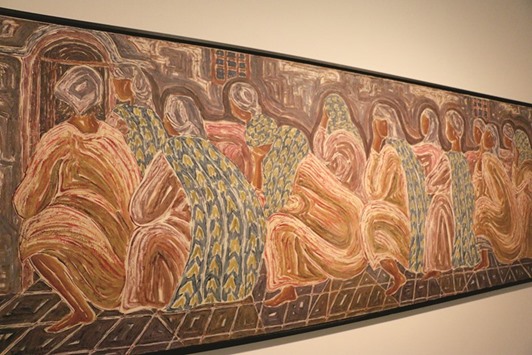
The Girl of Port Said, Oil on Canvas, 1957 by Inji Efflatoun. Right: The Tree of Freedom and The Bars paintings by Inji Efflatoun.
The artworks present in the gallery of the museum focus on the years between 1952 and 1982. Born in Cairo, Efflatoun was not only a painter, but also a feminist and political activist who urgently investigated her heritage and sought to connect with Egyptian people.
The exhibition, curated by Leonore-Namkha Beschi, hinges on three key moments in the artist’s life and proposes to examine Efflatoun’s efforts to find her mother tongue through creating a unique artistic vocabulary.
“The visitor is invited to discover the artist’s engagement with political and social injustice, the transformative experience of her incarceration, and finally the manifestation of a unique style defined as her ‘white period’,” says the curator.
Efflatoun’s upper-middle class origins made her feel uprooted and captive to an elitist upbringing for which she developed a forceful sense of resistance, which she explores in her portraits of Egyptian workers.
The focus on her time behind bars (1959-1963) at the Abi Zaabal and Qanater women’s prisons allows for identification of two distinct periods; first, when the artist scrutinised the human condition in a series of prisoners’ portraits, and second, when she decided to reorient her artistic production towards the subject of nature and the repeated figure of the tree as a symbol of freedom.
The post-incarceration paintings signify the reinvention and the affirmation of her inner freedom as a pictorial statement.
“The exhibition explores notions of the confinement and constraint imposed by society and prison rules and how they impacted the artist’s production as she diligently worked towards finding a singular artistic language,” the curator adds in the notes on the exhibition.
Efflatoun’s unfailing courage to fight for freedom, whether her own or that of others circumstances, is revealed as a powerful source of inspiration for the younger generation, while also being representative of the social and political changes witnessed in Egypt during her life time.
She dedicated her work to Egyptian rural life and she fought zealously for social justice and women’s rights. She tied her artistic production to the cyclic lives of the underprivileged, whom she called ‘the Others’, and depicted the Fellaha as the legitimate pride of Egypt.
The artist’s involvement in the nationalist struggle materialised in her first solo show at the Galerie Adam le Caire in 1952. Descendante de Hatshepsut (Descendant of Hatshepsut) 1953 symbolises what Efflatoun saw as the true origin of the Egyptian people and was included at the Sao Paulo Biennial that same year.
The equally powerful The Girl of Port Said (1957) dramatically expresses the artist’s interpretation of the suffering of Egyptians. The artwork depicts the horror of a child sitting next to the body of her dead mother in a pool of blood.
Efflatoun intentionally magnified the emotional impact of the scene through her use of intense colours and her exaggeration of the child’s facial expression. This forceful image also carries traces of European Expressionism, presenting a subjective and distorted reality in order to generate mental images and concepts.
In her memoir From Childhood to Prison, Efflatoun describes the mix of relief and anxiety she felt when she was arrested on June 19, 1959.
While an end to a life in disguise appeased the activist in her, as an artist was concerned about having the strength to handle prison life.
During her first two years in prison, Efflatoun exhausted herself depicting the intimacy of women prisoners in numerous portraits. Anguish anchored in the reality of detention was expressed through the intensity of the stares of her inmates, the verticality of the stripes on the uniforms, and the constant compositions built around bars as the background.
Soon after, the artist fed up with this hypersensitivity, began to dream about the outside world and redirected her production towards the subject of nature.
Efflatoun was imprisoned for four and a half years and painted throughout her incarceration. In July 1963, she was released from incarceration and painting became her main activity until her death in 1989.
Efflatoun works can be found in her permanent collection at Amir Taz Palace in Medieval Cairo where more than eighty works and a collection of her personal items are displayed; in the collection of Mathaf: Arab Museum of Modern Art in Doha; and the Museum of Egyptian Modern Art in Cairo.



